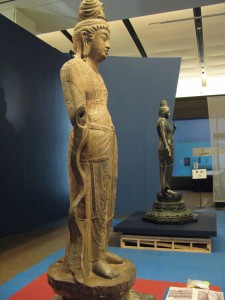After spending some time in Osaka seeing the sites, ( bunraku, fugu, kobe beef, Ceramics Museum, shopping) I headed to the city of Nara ready to get down to work. I arrived at the museum with the intention of condition reporting our statue and its base and then overseeing the crating of each. If time permitted I would do the same for a small statue from Philadelphia Museum of Art. The pieces had been loaned for the exhibit “Imperial Envoys to Tang China: Early Japanese Encounters with Continental Culture”. A very important and huge exhibit that traced Chinese influence on Japan during the Nara Period (710 CE- 794 CE). Over 200,000 people attended the exhibtion making it a huge success, and a great addition to the celebration of the 1300th anniversary of Nara becoming the capital of Japan. People from all over Japan came to see the exhibit and had very nice things to say about it.
The crating of an object can always be a bit tricky, particularly when there is a language barrier and a lot of chefs in the kitchen. The process involved my packing requests going through a translator who would relay my message to the chief curator who discussed this with the head of the packing company (Nippon Express) who would then tell his staff what to do. This, coupled with the fact that there were 8 guys doing a bunch of things at the same time while I tried to condition report and photograph the piece made the situation a little tense. Try doing your job with 12 people watching your every move and slightly annoyed that they can’t just be left alone to do what they do best in the quickest way possible.
Then there are the things that you didn’t plan for but must be dealt with. Is it okay to add a strap around to the statue? Yes. Can we put some paper between the statue and this bracket? Okay. Do you have any preference for how this gets put on the palette? Horizontal with no stacking. Do we have shipping labels? We need to print them. And so it goes, with decisions made on the fly and slight deviations from the plan at every turn.
On the eight hour trip from Nara to Tokyo: Do you stay with the truck that contains the statue on the side of a busy highway while a flat tire gets fixed, or seek a safer spot and use a cellphone to stay in contact? The answer isn’t always so clear cut when priceless artifacts are involved.




With all the pieces safely back in their crates we rolled them into the vault and headed out for a much needed party with the rest of the couriers and staff from the Nara National Museum.
